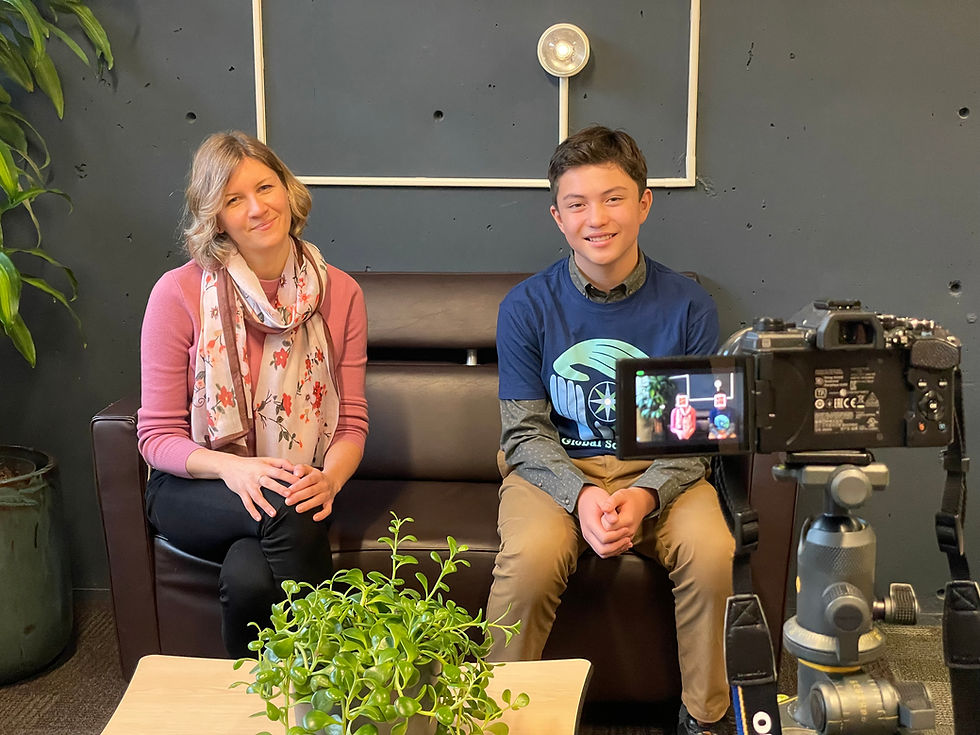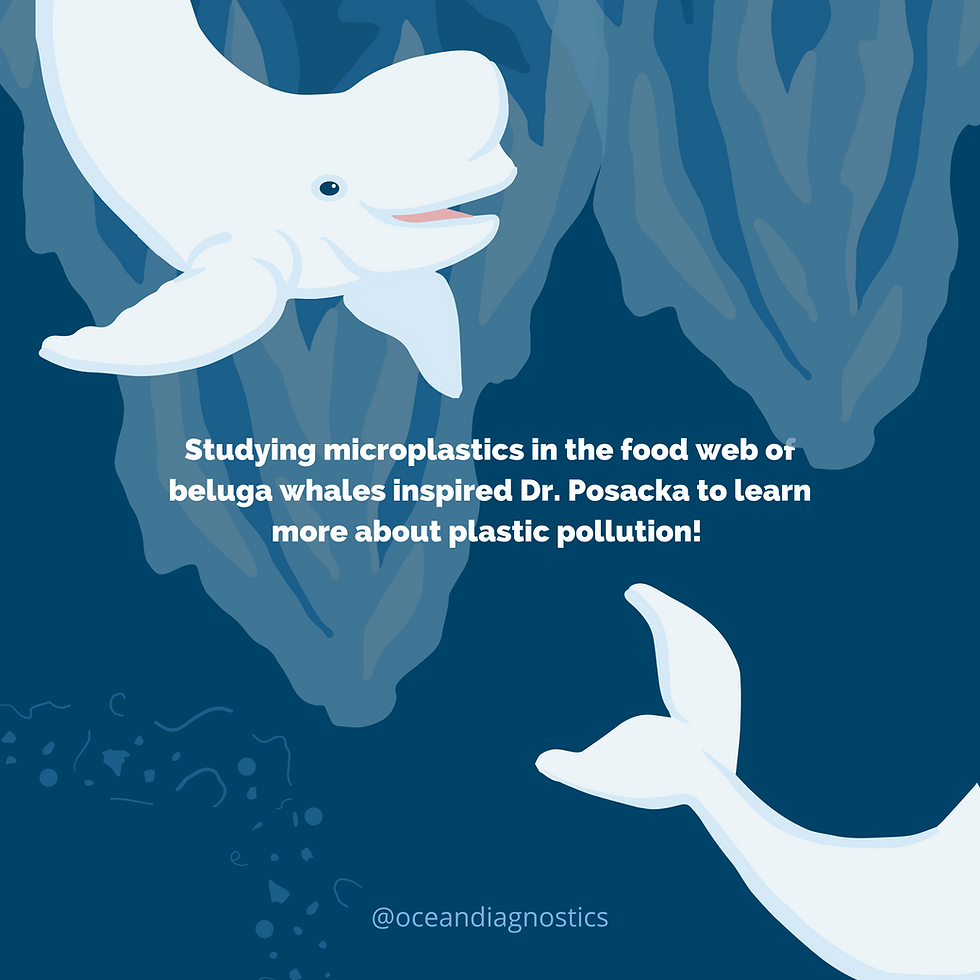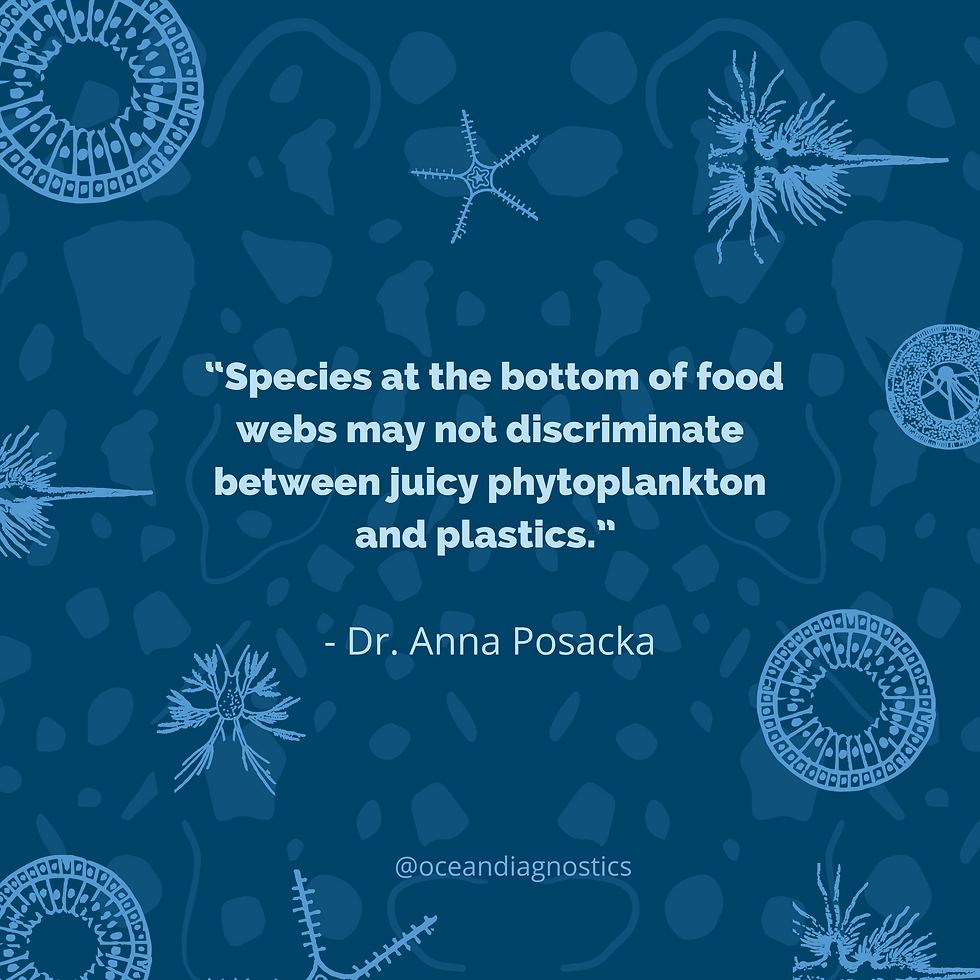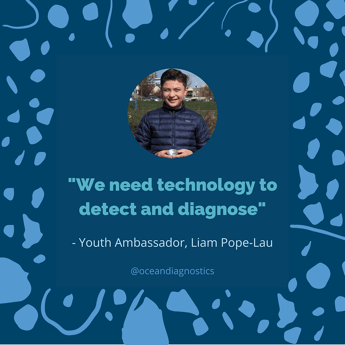Microplastics: an Important Piece of the Ocean Pollution Puzzle
Microplastics: An Important Piece Of The Ocean Pollution Puzzle
Youth Ambassador Liam Pope-Lau interviews Dr. Anna Posacka to learn more about microplastic pollution
Youth Ambassador, 11-year-old Liam Pope-Lau, interviews Ocean Diagnostics' Chief Scientific Officer, Dr. Anna Posacka, in honour of Women in Science Day!

In their conversation, Dr. Posacka discusses how she got started in microplastic research, the potential threats microplastics pose to our health and ecosystems, and how microplastics are a piece of a larger puzzle in terms of ocean threats. She notes studying and reducing microplastic pollution can have simultaneous positive impacts on other ocean threats. Lastly, she shares inspiring suggestions to reduce our plastic use.
Scroll down for the interview highlights or dive into our Q&A below!
Liam starts the interview by asking Dr. Posacka how she got started in microplastics research and what her work entails.
As an ocean scientist, Dr. Posacka spent years studying ocean chemistry and biology. During her ocean research, she came across a pollutant of growing concern: microplastics.
Microplastics are plastic pieces 5mm in size or smaller and they come from different synthetic materials, which makes researching their impacts difficult. She quickly discovered that microplastics are everywhere and their properties are highly complex, but she was curious to learn more and eager to help piece the puzzle together.
"By preventing plastic pollution in the first place, we can solve a lot of microplastic pollution,” Dr. Posacka.
"When I started working on microplastics, I realized they are part of a larger problem we have: plastic pollution. Many microplastics come from big plastics. By preventing plastic pollution in the first place, we can solve a lot of microplastic pollution,” says Dr. Posacka.

Dr. Posacka’s research addressed questions like Where do microplastics come from? How do they get into our environment? Which animals do they affect? How best can we identify their sources? Her work includes studies on the role of our clothes in the global microplastic problem and how microplastics move through the Beluga whale food web in the Arctic ocean.
Ocean Diagnostics is thrilled to have her expertise to advance lab techniques to efficiently analyze microplastics and help researchers and decision-makers to trace them back to their sources.
Skip to this question:
Knowing microplastics are everywhere, leads Liam to ask: “How do microplastics affect what we all have in common, like food, the economy, wildlife and health?”
Dr. Posacka explains, “scientists are still working to learn more about the impacts of microplastics on our ecosystem, health and economy, but they are several things that we already know. We know they get ingested [by wildlife], we know we are exposed, and we know, like larger plastics, microplastics are made from polymers.”
Some scientists estimate certain polymers can take up to 1,000 years to break down, explains Dr. Posacka.
Dr. Posacka highlights that the qualities of plastic polymers make them a concern for our environment. For example, plastic polymers:
Can last in the environment for a very long time:
-
When plastics enter the environment, they remain there for a significant amount of time. Plastics’ durability makes them an attractive product but can cause trouble in our environment. Some scientists estimate certain polymers can take up to 1,000 years to break down. If each generation is around 25 years, plastics in the environment now will be there for 40 more generations; that would be about the same time as your kids having kids 40 times over!
Can have harmful chemicals added to them:
-
You might be wearing plastics with certain chemical additives right now, without even knowing. Plastics can contain different chemicals, depending on their use. For example, textiles tend to be built with plastic fibers like polyester, nylon, and acrylic, and treated with chemicals, like those that make them fire-resistant or waterproof. When released into the environment, these chemical additives can leach off the plastics and into the environment or organism that ingests them.
Pose a physical hazard to some species:
-
Imagine you are a tiny zooplankton, enjoying a drift about the sea, and you come across a microplastic. Zooplankton can be about the size of cracked pepper. From the perspective of a tiny zooplankton, some microplastics would be rather large! They can also look like food. Dr. Posacka explains, “species at the bottom of the food web [like zooplankton], may not discriminate between a juicy phytoplankton or a plastic fiber. Microplastics do not have nutritional value and may negatively affect the nutrients these species get.” This is an issue because animals at the bottom of food webs are key diet items for other ocean species. If the bottom of the food web is affected, there may be a ripple effect impacting top predators.
-
You might remember one famous zooplankton, “Plankton,” from SpongeBob SquarePants. Plankton is a copepod, one of the most common classes of zooplankton in our seas. “Plankton” and other zooplankton are important animals in our oceans, and due to their size, microplastics may indeed pose a physical threat.

There are still many questions. Dr. Posacka explains, “we are putting huge quantities of plastics into the ocean, and we can’t really predict what their impact will be.”
Skip to this question:
Liam believes that technology may play an important role in helping address the issues of plastics pollution. He recalls joining a beach clean-up and noticing that microplastics were extremely hard to take out of the environment by hand. He asks Dr. Posacka “What role does technology play to help solve these problems?”
"Technology plays a huge role. Microplastics come from many sources and they can change dynamically in the environment,” answers Dr. Posacka. We need technologies to simplify these complexities and scale research up to global levels. Technology can help us understand microplastics’ fate and transport in the environment, how microplastics move about the oceans, where they accumulate and more.
“When it comes to microplastics,” Dr. Posacka says, “technology is so important because they are so small and diverse. We need to develop smart tools to capture this information efficiently.” When technology can scale our understanding of microplastics’ sources and accumulation zones, we can use this information to inform solutions and policy, to prevent more microplastics from entering the environment, and to mitigate the effects of microplastics already there.
If we improve how we manage this waste and if we transform our relationship with plastic garbage, there are many benefits.
“There are still a lot of pieces to put together,” says Dr. Posacka, “and we still don’t fully understand the fate of microplastics and plastics in the environment. By addressing plastics, we can also solve other pollution problems.” Dr. Posacka mentions that plastics share pathways and sources with many other chemical pollutants in our oceans. For example, wastewater can carry a combination of pollutants from our own home, streets, and industries to the environment. If we improve how we manage this waste and if we transform our relationship with plastic garbage, there are many benefits. For example, if we are more aware of where our waste ends up, we can stop other contaminants from entering the environment, as well.
 “Plastics and other environmental issues that our planet faces are global problems, and they are very complex,” explains Dr. Posacka. “Technology helps us study these complex global issues in an efficient way.” Plastics are one piece of the puzzle in terms of ocean threats. Issues such as over-fishing and other chemical contaminants can also be addressed with advancing technology. Using technology to understand the extent of the problem and inform solutions is being adopted to fight plastic pollution, and it can be adopted to fight and inform policies for other pollutants, too.
“Plastics and other environmental issues that our planet faces are global problems, and they are very complex,” explains Dr. Posacka. “Technology helps us study these complex global issues in an efficient way.” Plastics are one piece of the puzzle in terms of ocean threats. Issues such as over-fishing and other chemical contaminants can also be addressed with advancing technology. Using technology to understand the extent of the problem and inform solutions is being adopted to fight plastic pollution, and it can be adopted to fight and inform policies for other pollutants, too.
Liam chimes in, “we need technology to detect and diagnose!”
Skip to this question:
Liam, who has participated in beach clean-ups himself and is a leader in the community scientist community, asks Dr. Posacka how the public can help.
“Volunteers, citizens and communities collect essential information about the types of plastics currently in our environment,” says Dr. Posacka. Volunteers expand the reach of scientists and collect information in areas scientists haven’t studied yet. Community scientist programs in Canada like, the Great Canadian Shoreline Clean-up, helped to influence policies to address single-use plastics.
Dr. Posacka highlights 3 areas in which citizen scientists make waves in microplastic research:
-
Community science can have a huge role in inspiring our governments to take action.
-
It helps researchers gather information about the nature of the problem at scale, which they may not otherwise have time to do.
-
It helps individuals and communities better understand and connect with the problem we are creating.
Liam’s beach clean-ups inspired him to learn more about environmental sciences and propelled him to act. “Seeing all of this waste in our environment has been quite transformational,” agrees Dr. Posacka. In reflection, she notes that community science gives us a chance to turn our own skills and interests towards a problem that we can solve together.
Skip to this question:
In the final moments of our interview, Liam asks, “if there was one key message you could share about microplastics, what would it be?”
“Lead by example,” encourages Dr. Posacka, “and be the change that you want to see.” We know microplastics can come from larger plastics, so avoiding unnecessary plastic purchases is one way to fight plastic pollution. We should make responsible purchasing decisions and, when we can, reuse or repair what we already own. Extending the life of clothing that may have a small rip or refraining from purchasing one bagged bread a week are two quick things Canadians can do.
“There is one estimate that the average Canadian uses 200 plastics bags per year,” Dr. Posacka.
“There is one estimate that the average Canadian uses 200 plastics bags per year,” Dr. Posacka explains. If we refuse plastic bags and we inspire ten friends to do the same, we are potentially saving the environment from 2,000+ plastic bags.
Dr. Posacka also suggests a plastic audit in your household. It can help contextualize the amount of plastic products we use every day.
See the full interview below:
Ocean Diagnostics has partnered with Environment and Climate Change Canada to run a national campaign to educate and engage Canadians about microplastic pollution. To do so, we have teamed up with Canadian experts to share scientific information on what microplastics are and where they come from, how they affect our environments and communities, and what the public can do about it. Learn more!
Subscribe to our newsletter for more information from microplastic experts!
Ocean Diagnostics Inc is an environmental impact company that develops technologies and laboratory capabilities to standardize microplastics data collection and analysis. The company works closely with academic and government partners to advance microplastic science. ODI has partnered with Environment and Climate Change Canada to share information on plastic pollution from Canadian plastic experts. Learn more here.
Follow #BeatPlasticPollution for the latest news.
